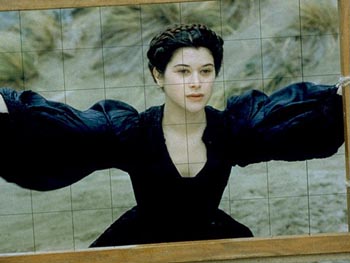Painterly Lust
Frame Job: Artemisia Gentileschi (Valentina Cervi) prepares a grid for one of her historical canvases.
More romance than technique
THE OLD CUSTOM of regarding women as artists second and women first is still popular in even the most high-toned movies. Recently, Dangerous Beauty featured the courtesan Francesca as lovelorn soul. Somewhat more interesting than Dangerous Beauty, but just as unlikely, is the Franco-Italian production Artemisia, the biography of Artemisia Gentileschi (1593-1652), whose Judith Beheading Holofernes is one of the earliest known paintings by a woman. It's tantalizing that the first renowned woman painter would take as her subject the killing of Holofernes. He was Nebuchadnezzar's underling, deceived and decapitated by an Israelite woman. Gentileschi's image of the heroic Judith has a double meaning: it depicts the bravery of a woman and demonstrates the unflinching ability of a woman to paint like a man (i.e., with drama, with blood).
Inevitably, the life of this female pioneer has been made into a love story about the passion of the young artist (the kittenish Valentina Cervi) for her teacher, Agostino (Underground's Miki Manojlovic). When Artemisia's father discovers them together, he has Agostino arrested for rape. The film ends in a trial that unfortunately echoes Dangerous Beauty's line "If passion is a crime, let me be sentenced to the full extent of the law."
At its most worthwhile, Artemisia examines the tools and techniques of 17th-century art--all of the interesting machinery of an age when art was meant to reproduce the outside world, rather than the internal world. Unfortunately, the subtle power of Gentileschi's painting is missing. It's a power experienced, for example, in her later work Judith and Her Maidservant, in which two women nervously mop up after the assassination of Holofernes. Here's an image of a woman's life in a world where men are kings. The picture stresses stealth and a warning of consequences to come; it is made with the knowledge, as Sister Wendy Beckett has written of it, "that innocence is no defense."
Although the film opens with an image of secrecy--Artemisia taking a candle into her bed to view the hidden contours of her own body--it indulges in splashy public gestures inconceivable in her time. In Gentileschi's day, artists lived in the same realm as scientists. Agnes Merlet's movie takes that science away, making the heroine a slave to the heart and a fool for New Agey vagueness. Merlet's Artemisia is a subject fit for a Harlequin romance.
[ San Jose | Metroactive Central | Archives ]
Copyright © Metro Publishing Inc. Maintained by Boulevards New Media.
![]()

Umberto Montiroli
Artemisia (R; 96 min.), directed by Agnes Merlet, written by Patrick Amos, Christine Miller and Merlet, photographed by Benoît Delhomme and starring Valentina Cervi.
From the May 14-20, 1998 issue of Metro.
![[Metroactive Movies]](http://metroactive.com/movies/gifs/movies468.gif)